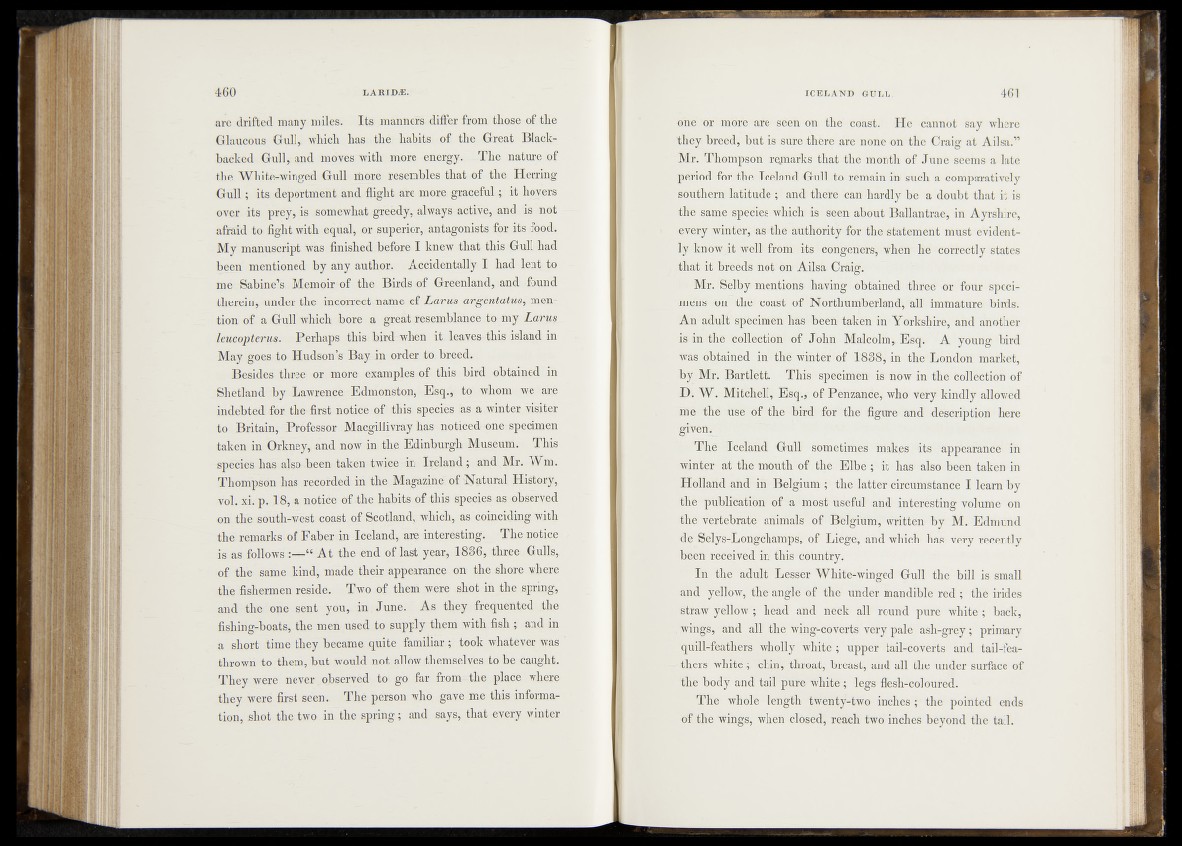
are drifted many miles, Its manners differ from thosmof the
Glaucous Gull, which has the habits of the Great Black-
backed Gull,-and moves with more energy— The naturp$rf
the White-winged Gull more resembles that of the HeEtpig
G u ll; its deportment and flight are more, graceful; it holers
over its prey, is somewhat greedy, always active, and is not
afraid to fight with equal, .or superior,, antagonists for its food.
My manuscript was finished before I knew that this Gull had
been mentioned by any author.-, Accidentally I hadf^enfet®
me Sabine’s Memoir of the Birds of Greenland, -and f^und
therein, under, the incorrect mam_e«i®$ Larvs argentatus,
tion o f a Gull which bore a great:fesemblance Jikmy Larm_
leucopterus. Perhaps this bird when it. Ieav,es4his island in
May goes to Hudson’s BayJn order to. breed*,
Besides three or more example,s^of thisy-hirds#pbtained in
Shetland by Bawrence Edmonsto%',Esq.,i4fr ^ho-m we are
indebted for the first notice of this species. Jas a winter y S f#
to Britain, "Professor Macgillivray has noticed^onexspeciinpn
taken in Orkney, and now in the Edinburgh Museum, ^jhis
species has.alsaJbeen-takemtwice-m Ireland*; a n d W m .
Thompson has recorded in the Magazine, of.'^gfu-ral. History,
vol. xi.'ft'lfSja notice of .the habits of this speQies.asmb&eBygd
on the south-west coast of Scotland^ which, as coinciding with
the remarks of Faber in Iceland, are interesting'". The»<s>%e
is as follows :—“ At the end of last year, 1836, three Gulk,
of the same kind, made their appearance on the shore where
the fishermen reside. Two of them were shot in the spring,
and the one sent you,...in. June. As they ■ frequented the
fishing-boats, the men used to supply them with.fish.; and in
a short time they became quite familiar ; took whatever was
thrown to them, but would not allow themselves to be caught.
They were never ..observed to go far from-the place y c k |||
they were first seen. The person who gave me this information,
shot the two in the spring; and says, that every winter
oh^ ’or' more* are seen on the coast. He cannot say where
ths^lÉreëd'bbut-is sure tKbre are none on The Craig at Ail sa.”
Mr. Thompson remarks that the month of June seems a late
period fofltheidc^^i'diGufl'.to'remain in such a comparatively
■SO’iMaern laÉéMp^andïthe%e can hardlyMbe a doubt that it is
t-hë' whichi4s4^e'@h about Ballantrae, in Ayrshire-,
yeV.eby win'#r,%si-the authority»for the-statement must evident-
^«owJ^welLfroi^SjfesI co tfë f^ llw h en he^ebîééfetly states
rftat'5
prfMrilSélby menfio^l shaving ^obtained -three or fotir speci-
mén sen the -e:Oa^4fPf’orthumberland, all immature birds.
,IÉt^aiT|lÉ'specimen has»'*been'taken in-Yorkshire, and another
dsdn » t h e o f * J b l n ^Malcolm, Esq; A yottiÿ bird
w ^ i^ ^ h ed iv in HM^-ijHtef’of in ^ ti^L ondom market,
Iky Mr. BarlMt% This "spë o im 'eh ^ -how in the*collection of
D. W . Mitbhell, Esq.ö^éfe^todey who veryS'kifidly allowed
Tné'îdhc -usb pfrthe bird forffMifigure and description' here
■givèn^'”
The Gulf ïriakgs ^tsïlâppëarance in
winfer^àf'f^ê' rnöuth of the E l b e - h a s also been taken in
Holland and |Ê | Belgium ; the lattbr^'telfèlinlstatlce I learn by
^ a e publication-©Pa mol^isefük^and interesting volume on
thf^mt-brate animals of BèlgmtaÇ'written M. Edmund
6euSelys-Longchamps,fof 'Liëg^f%hd' which- has very recently
ïb’eëfi frebVived ,i®^.^c6fcnt¥y.
^T ri 'tîît* "‘adult Cesser White-winged 'Gull thlpbill is small
and the undfet mandible red ; the irides
Mrawtyéltów fjB ead aifd ndeH all round pure white ; back,
, wih'gs, and all1 the wing-covert's very pale ash-grey ; primary
ifqùiH-l^thers wholly white; upper tail-coverts and tail-fea-
Mrhërs white ; chin, throat, breast, and all the'Under surface of
phC body and r l i f pure white ; legs flesh-coloured.
The WnM^pength twenty-two inches r the pointed ends
of the wings, when closed, reach two inches beyond the tail.